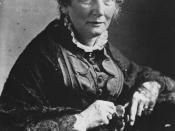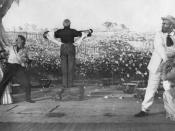Uncle Tom's Cabin
Harriet Beecher Stowe, author of the powerful antislavery novel Uncle Tom's Cabin, was perhaps the most influential woman of her time. By opening America's eyes to the injustice of slavery, her masterpiece changed the course of history. Born in Litchfield, Connecticut, in 1811, Harriet Beecher grew up under the guidance of a sternly religious father (Jakoubek 36). In 1832, she moved with most of her family to Cincinnati, Ohio, where she met and married theologian Calvin Stowe and began publishing articles in local magazines and newspapers (Ferguson 356). Living across the Ohio River from the slaveholding state of Kentucky, the young writer met both abolitionists and fugitive slaves, who told her of the cruelty of life bondage. By the time she left Ohio with her husband and five children, Stowe was convinced that slavery had to be abolished immediately (Ferguson 356). She settled with her family in Brunswick, Maine, and there composed Uncle Tom's Cabin, which she hoped would demonstrate slavery's wrongs to the nation.
Published in 1852, the book caused an immediate sensation and sparked heated debate (Jakoubek 49). In 1861, the slavery conflict erupted into the Civil War, which ultimately led to the emancipation of American slaves. Stowe continued to write and lecture after the war's conclusion in 1865, composing stories of the life in early New England and speaking out on a variety of topics, including feminism (Jakoubek 106). Yet, since her death in 1896, she has been best remembered as the author of Uncle Tom's Cabin, the book that helped American blacks with their freedom. Beecher's main purpose for writing Uncle Tom's Cabin was to paint to a picture of slavery so heartrending as to cause white people to rise against it (Karolides et al. 152). The intended audience was to reach...


